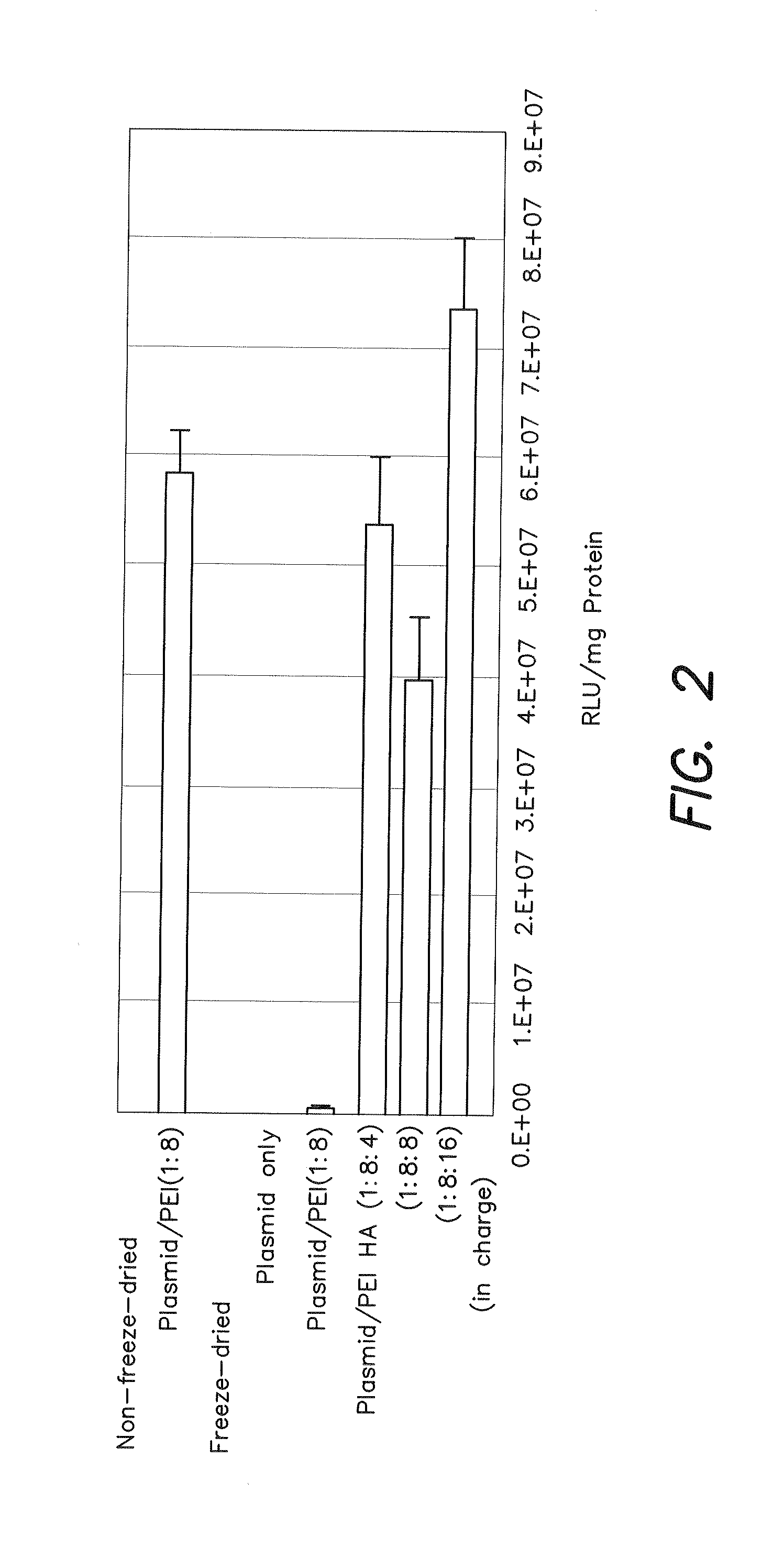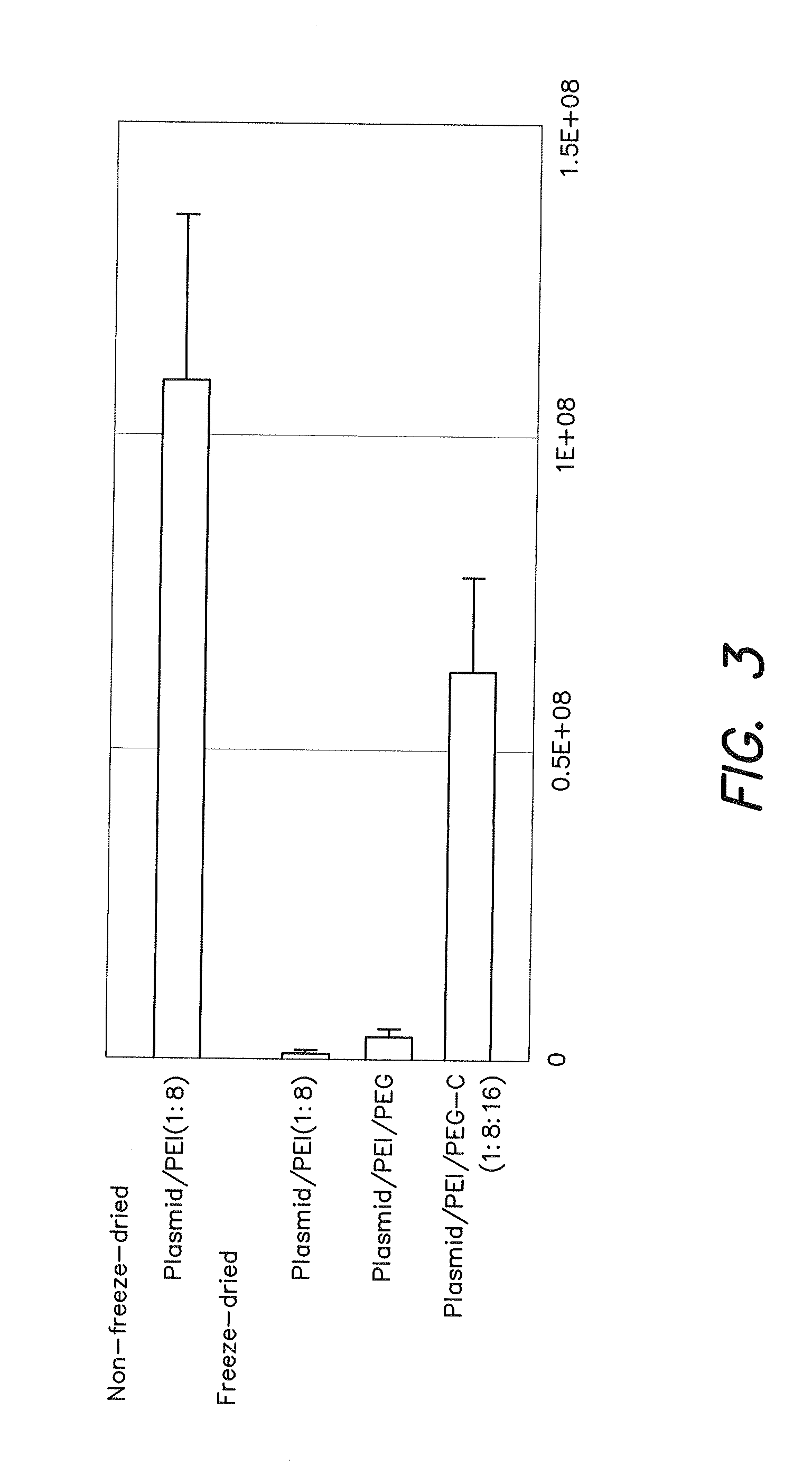Freeze-dried product for introducing nucleic acid, oligonucleic acid or derivative thereof
a technology of nucleic acid and oligonucleic acid, which is applied in the direction of biochemistry apparatus and processes, drug compositions, genetic material ingredients, etc., can solve the problems of difficult to prepare these complexes with satisfactory reproducibility, difficulty in adjusting concentration and bothersome handling, and pain in delivery to target cells
- Summary
- Abstract
- Description
- Claims
- Application Information
AI Technical Summary
Benefits of technology
Problems solved by technology
Method used
Image
Examples
example 1
Gene Expression by Freeze-Dried Product of a Plasmid / Polyethyleneimine (PEI) / Hyaluronic Acid (HA) Complex
[0073]A freeze-dried complex comprised of the three components of a gene, PEI and HA was incubated with mouse melanoma cell line derived B16 to confirm the expression of luciferase gene.
[0074]The same plasmid as that described in Non-Patent Document 6 (Biomacromolecules, Vol. 7, pp. 1274-1279) was used for the luciferase plasmid. Linear PEI (Polyscience, Inc.) having a molecular weight of Mw=25,000 was used for the PEI. Microbial hyaluronic acid (Nacalai-Tesque) was used for the HA. Phosphate Buffered Salts (tablet, Roman Industries) dissolved in ion exchange distilled water was used as PBS. This applies similarly to the following examples as well.
[Operation Procedure]
[0075][1] 316 cells were seeded into a 24-well multiplate two days prior to gene introduction and then incubated for two nights using EMEM medium.
[2] 2 μl of an aqueous solution containing 1.3 g of luciferase plasmi...
example 2
Effects of Mixing Order
[0080]Freeze-dried products were obtained by mixing with addition of PEI after first adding HA to luciferase plasmid in [2] of Example 1 followed by evaluating in the same manner as Example 1 .
[Results]
[0081]The results are shown in FIG. 2. In FIG. 2, values in parentheses indicate the ratio of PEI cations and HA anions to plasmid anions and more specifically, indicate the molar ratio of PEI and HA to DNA.
[0082]In contrast to hardly any gene expression being observed in the case of the freeze-dried plasmid / PEI binary complex, high expression was observed in the case of addition of HA, and in the case of freeze-drying after mixing plasmid, PEI and HA at a ratio of 1:8:16 (in terms of charge), expression efficiency with an additional 26% or more higher than the plasmid / PEI binary complex prior to freeze-drying was demonstrated. On the basis of these results, high expression was clearly observed even if the order of mixing is changed.
example 3
Gene Expression by Freeze-Dried Product Containing Plasmid / PEI / PEG Derivation Having Carboxyl Side Chains (PEG-C)
[0083]In Example 3, PEG-C having a molecular weight of about 10,000 and containing about 18 carboxyl groups per molecule was used as anionic polymer after synthesizing according to the method described in Non-Patent Document 1 (J. Biomater. Sci. Polymer Edn., Vol. 14, pp. 515-531 (2003)).
[0084]A freeze-dried three-component complex comprised of a gene, PEI and PEG-C was incubated with mouse melanoma cell line 316 followed to confirm the expression of luciferase gene.
[Procedure]
[0085][1] B16 cells were seeded into a 24-well multiplate two days prior to gene introduction and then incubated for two nights using EMEM medium.
[2] 12.5 μl of an aqueous solution containing 1.3 μg of luciferase plasmid was mixed with 12.5 μl of an aqueous solution of PEI to a − / − ratio (charge molar ratio) of 8 on the day prior to gene introduction, and after pipetting several times, 25 μl of PEG-...
PUM
| Property | Measurement | Unit |
|---|---|---|
| temperature | aaaaa | aaaaa |
| temperature | aaaaa | aaaaa |
| pressure | aaaaa | aaaaa |
Abstract
Description
Claims
Application Information
 Login to View More
Login to View More - R&D
- Intellectual Property
- Life Sciences
- Materials
- Tech Scout
- Unparalleled Data Quality
- Higher Quality Content
- 60% Fewer Hallucinations
Browse by: Latest US Patents, China's latest patents, Technical Efficacy Thesaurus, Application Domain, Technology Topic, Popular Technical Reports.
© 2025 PatSnap. All rights reserved.Legal|Privacy policy|Modern Slavery Act Transparency Statement|Sitemap|About US| Contact US: help@patsnap.com



